In this post, we take a detailed look at the Virtual Jeff Pro digital whammy guitar system.
Discover its innovative features, explore its versatility, and learn how it can revolutionize your guitar playing experience.
Whether you’re a seasoned pro or just starting out, the Virtual Jeff Pro offers something for every guitarist looking to elevate their sound.
This Post May Contain Affiliate Links
In compliance with the FTC guidelines, please assume that some of the links on these posts and sites are affiliate links (Amazon or others) from which I may earn a small compensation/commission from sales of certain items at no extra cost to you from qualifying purchases.
Anytime you see a link that looks like “astore.com, paid link, #ad, #CommissionsEarned or Amazon/Amazon.com/ca,”… it can be assumed that it is an affiliate link.
To learn more, follow the link below.
A Look At The Virtual Jeff Pro
Introduction
The Whammy bar/Tremolo arm or Vibrato system is a dynamic and expressive tool that has left an indelible mark on the music world.
Originally designed to mimic the sound of a pedal steel guitar, the hardware and design quickly became a favourite tool of rock guitarists looking to add flair and expression to soloing.
From subtle vibrato to wild dive bombs, this simple yet versatile device has been a staple in guitarists’ arsenals across various genres.
In this blog post, we’ll explore the history of the more well-known Vibrato systems and the new addition to the Guitarist’s toolbox, the Virtual Jeff Pro.
What’s In The Name
Whammy Bar
The electric guitar “whammy bar” is a name inspired by Pioneer rock guitar soloing artist Lonnie Mack after the title of one of his instrumental hits, “Wham,” in 1958.
Mack favoured the Bigsby on one of the first Gibson Flying V’s productions so much that the setup became his signature guitar, with Neil Young saying…
“You’ve got to look at guys like Lonnie Mack. He showed everybody how to use a wang bar.”
Tremolo Arm
The device introducing the term Tremolo arm was first filed and released in 1954.
It was attributed to Leo Fender, who named his Stratocaster mechanical vibrato system a “Tremolo Device for Stringed Instruments.”
The reversal of Terminology was not accurate, for the guitar tool could produce a variation of pitch, including vibrato, but could not rapidly modulate volume or “Tremolo.” However, despite the inaccurate depiction, the name stuck and is part of the legacy.
The Original Bar
Doc Kauffman created and designed the world’s first patented mechanical vibrato unit. The initial patent was filed in August 1929 and officially published in 1932.
In the late 1930s, Rickenbacker produced the first commercial batch of electric Spanish guitars, utilizing the Kauffman “Vib-rol-a” as a stock option.

A front view of the Kaufmann Vib-Rola tailpiece as mounted on a 1935 Rickenbacker electro-Spanish guitar -Image courtesy of Wikipedia-Author Atlantaspike and is released into the Public Domain.
What It Does
A vibrato system is a mechanical device that temporarily changes the pitch of the strings by changing the tension, typically at the bridge or tailpiece of an electric guitar.
Using a controlling lever, the player can quickly and temporarily vary the tension and sometimes length of the strings, changing the pitch to create an effect.
Common Challenges to the Original Designs
Overall, while the vibrato systems can add a lot of versatility and expression to a guitar’s sound, they still come with challenges and potential issues that players should be aware of.
-
Tuning Stability: One of the most common issues with Electric guitars with vintage-style vibrato systems is that they can cause the guitar to go out of tune, especially with aggressive use. This is due to the tension changes caused by using the bar, which can affect the strings’ pitch and are not exactly known for returning to pitch correctly.
-
String Breakage: The increased tension and bending of the strings when using a bar can sometimes lead to string breakage, particularly if the strings are old or worn.
-
Bridge Alignment: Tremolo bars are typically attached to a bridge that pivots on two posts. If the bridge is not aligned correctly or set up, tuning and intonation issues can occur when using the bar.
-
Sustain Loss: Some players find that using a bar can lead to a loss of sustain, particularly on guitars with floating bridges. This is due to the increased string tension caused by the bar pulling the bridge up.
-
Hardware Wear: The constant use of a bar can cause wear and tear on the guitar’s hardware, including the bridge, tremolo arm, and tuning pegs. This can lead to issues such as loose parts or a lack of responsiveness from the unit itself.
-
Setup Complexity: Setting up a guitar with a tremolo bar can be more complex than setting up a guitar with a fixed bridge. Proper setup is essential for optimal performance and tuning stability.
-
String Buzz: The increased string tension and movement caused by using a bar can sometimes lead to string buzz, particularly if the guitar is not correctly set up.
-
More Difficult to String: A vibrato-equipped guitar is typically more difficult to re-string and tune than a fixed tailpiece.
4 Basic Designs
All modern Tremelos are based on one of 4 basic Tailpiece designs.
-
Bigsby Vibrato – introduced and used on Gibson, Gretsch, and Rickenbacker guitars, with the US Patent filed in 1952.
-
Fender Synchronized Tremolo – introduced on the Fender Stratocaster in 1954, which inspired many more modern designs, including the Floyd Rose Locking system (more on this later)
-
Fender Floating Bridge, which has two main variants:
-
Fender Floating Tremolo – introduced on the Fender Jazzmaster (1958)
-
Fender Dynamic Vibrato – introduced on the Fender Mustang (1964)
-
-
Cam-driven designs based on pedal steel guitar concepts that include…
-
Kahler Tremolo System (1979)
-
Let’s Examine The Top 3
- Bigsby Vibrato
- Fender Synchronized Tremolo
- Floyd Rose Locking system
Bigsby

Logo of Bigsby, a guitar-related manufacturing company-Author unknown- Image courtesy of Wikimedia-and is released into the Public domain
One of the earliest examples of a Tremolo system on an electric guitar was designed by Paul Bigsby and known as the Bigsby Vibrato Tailpiece or simply Bigsby.
It was the first commercially successful design.
How It Works
The design uses a spring-loaded arm that rotates a cylindrical bar in the tailpiece, varying the string tension to create vibrato and other pitch variations.
The string tension is balanced against a short, helical compression spring under the arm pivot. (See Image)

Bigsby B50 Tremolo Hardware on Airline Coronado w/helical compression spring under the arm pivot-Image courtesy of Wikipedia- Author -And is licensed under the CC BY-SA 3.0
Downsides Of The Design
The Bigsby Vibrato system can send a guitar out of tune when returning to its original tension after a pitch bend, as those who play them have probably discovered the hard way.
Also, this system only allows for downward use.
Still Used Today
The Bigsby remains popular to the present, especially on hollow-body electric guitars.
It’s available as a factory-fitted option on top-line hollow and solid-bodied models from many makers and as an aftermarket addition.
It remains the only widely used design whose mechanism is entirely above the belly of the guitar body, making it particularly suitable for acoustic and semi-acoustic guitars.
After Bigsby, the next significant development was Leo Fender’s vibrato design; he popularized the system with the introduction of the Stratocaster, “Synchronized Tremolo.“
Fender’s design is ‘synchronized‘ in the way that the bridge saddles and string ends move together as one rigid unit, mostly eliminating sliding between string and saddle. Thanks to its floating bridge design, this allows for more controlled and dramatic pitch changes.
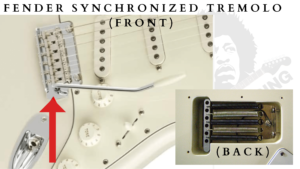
A Fender Modified 60s Stratocaster Electric Guitar, with synchronized tremolo system-Image courtesy of Amazon.com-Tap to see more.
Benefits
Unlike the Bigsby, the floating bridge can be utilized in both directions. It offers a greater range of pitch changes and better capability for up-bends.
This allows players to both lower and raise the pitch of notes, giving rise to expressive techniques such as dive bombs and fluttering effects.
Like the Bibsby, The Fender synchronized Tremolo design has virtually remained unchanged to the present day. It is still in production and is the most widely copied vibrato system.
Fender Design Etched In Rock History
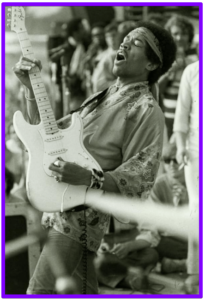
Jimi Hendrix performing on stage with a Fender Stratocaster and the synchronized tremolo system courtesy of Amazon.com-Tap to get a copy of the image.
Pushing Boundaries
Veteran Players like Jimi Hendrix and Jeff Beck have pushed the boundaries of what was possible with vintage tremolo designs.
They explored new possibilities and used them to create groundbreaking sounds and techniques that have become iconic in the world of rock and roll.
New Concepts
Newer Virtuosos like Eddie Van Halen and Steve Vai have taken the traditional vibrato system, which was extensively used in the 1980s metal-influenced genres, and contributed to the development of new Tremolo Concepts like the double-locking system pioneered by Floyd Rose.
These new designs eliminated many of the tuning issues associated with more basic tremolo arm models and allowed guitarists to freely use the tool.
Floyd Rose
Double Locking Tremolo
Inspired by the original Fender design, the Floyd D. Rose was made available in the late 1970s but with several extra mechanisms, like double locking.
With the addition of a second lock plate on the bridge nut and headstock, the system tightened the strings with hex key indexes, securing them in place and creating a more complex design.
Benefits Of The Floyd Rose

The Fender Stratocaster w/Floyd Rose system shows the bridge’s fine tuners and locking nut on the headstock. The image is courtesy of Amazon.com- Tap to see more.
The Floyd Rose provided a wide range of pitch variation and extra tuning stability, mainly while using the vibrato arm consistently and aggressively, but essentially eliminated the use of the machine heads for traditional tuning.
To accommodate after-locking tuning, fine tuners were added and provided as part of the bridge mechanism on all but the earliest units. (See side Image)
These tuners allowed for minor retuning without having to unlock the nut.
Did You Know
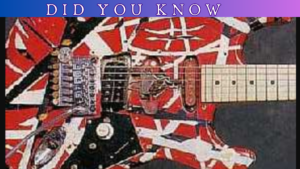
EVH Frankenstrat-Image courtesy of Wikimedia-Author Bainzy at English Wikipedia- and is licensed under the Public domain
It is rumoured that Eddie Van Halen contributed to the inclusion of the fine-tuners in the design.
In a 1982 Guitar World interview for Van Halen’s Diver Down album, Eddie claimed that he co-invented the fine tuners on the Floyd Rose Tremolo, but this was never confirmed.
The New Option For Non-Whammy Players
Do you not have a vibrato system but still would like an uncomplicated extra option for musical expression without having irreversible modifications done to your favourite instrument?
Enter a new addition to the Guitarist toolbox that moves the boundaries of creativity…
The FOMOfx Virtual Jeff Pro
Musical Instrument Technology
The company was founded in Australia and presented its first “Virtual Jeff” product at the 2016 NAMM show.
It is a revolutionary development in digital vibrato systems that features a Pro Controller’s quality buffer. This buffer ensures consistently exceptional signal quality and rapid tracking, offering unprecedented control and versatility.
Designed by guitar players, the world’s first “on-guitar digital whammy” is road-tested and fine-tuned for gigs, studios, and home use.
Following its success, the company soon developed the “Virtual Jeff Pro,” an enhanced version with extra features, including MIDI wireless communication between the whammy controller and the controller box and footswitch connections for generating effects and switching between presets. Note – The Hold/Blend footswitch is optional and available separately.
How It Works
Virtual Jeff Pro is a compact, cutting-edge device that attaches to the guitar’s body near the bridge.
It uses sensors to detect the guitar’s sonics and translates that into pitch changes.
It’s designed to emulate the workings of the classic vibrato system with unparalleled precision and flexibility without the associated downsides.
A Digital Vibrato System To Fit Any Guitar
This device works the same as a digital whammy peddle, but it gives you control via the guitar’s mechanical arm. (See image)
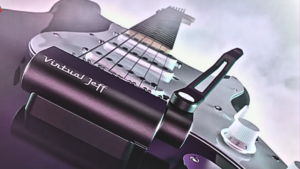
It fits most electric and acoustic guitars and basses. It is easy to install without tools—no holes or milling are necessary. The image is courtesy of Virtual Jeff Pro.
Whether you use the Virtual Jeff Pro for subtle effects or go all out with 80s-style “dive bombs,” the system will always bring out every nuance with zero latency while manipulating the notes’ pitch in real-time with its precise pitch control.
Feels like The Real Thing
Unlike traditional whammy bars, the string tension is not physically altered when using the digital vibrato arm, eliminating the problem of it correctly returning to pitch. However, it still provides a sensitive and responsive physical playing feel that is as real as conventional systems.
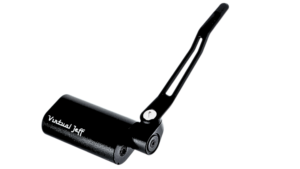
Virtual Jeff Pro Digital Vibrato Arm-Image courtesy of Reverb.com
Arm Specs
- Dimensions Whammy & Mount (W x D): 85 x 40 mm
- Weight Whammy & Mount: 110 g
Mounted With Ease No Modifications
This digital Whammy/Vibrato system can be easily fixed to the top of a 6-8 string solid body, electric acoustic, archtops, or bass guitars.
Players need not worry about their instrument’s finish when mounting the Whammy Bar Controller since the brackets’ adhesive surface is extremely kind even to sensitive nitrocellulose lacquer, and the latter can be removed without leaving any traces or residue behind.
How To Start With The Pro Controller
First, to plug it in, it simply goes from your guitar’s socket to the Pro Controller’s “input” 6.3 mm jack.
The signal is sent to the player’s amplifier or pedalboard via the Pro Controller’s “Out” 6.3 mm jack, and that’s it. Press active on the pedal, and you will be ready to go. (See Image)
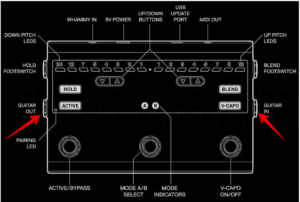
Controller diagram w/Input: 6.3 mm jack and Output: 6.3 mm jack – Image courtesy of thomannmusic.com
2 Ways To Line In Your Guitar
Firstly, a Custom wired (13ft/4m) 8th-inch cable can connect from the digital arm to the controller floor unit, and you can run the Jeff Pro and guitar lines together.
Alternatively, it comes with a rechargeable Bluetooth Mini-Link 2.4GHz transmitter unit adaptor that pairs with the controller wirelessly and can be clipped to a guitar strap.
The arm is connected to the Mini-Link via a shorter 8th-inch wired operation data cable (1ft/0.6m), resulting in fewer cables for the floor unit and peddles.
Both ways work well, giving you a couple of setup options.

Jeff PRO digital bar controller set includes a power supply, carrying case, 2 mounts and adhesive, 1 mounting adapter & belt clip, 0.6m MiniLink cable, and 4m cable – Image courtesy of Reverb.com.
Pro Controller Tech Specs
Dimensions (W x D x H): 154 x 99 x 36 mm /Weight controller: 510 g
Pitch Processor
The pro controller is installed with a transparent pitch processor, preserving all of the tones and dynamics of your original guitar.
Own Power Supply
It has its own power supply to help charge and pair with the Bluetooth Mini-Link wireless adaptor.
Zero Lag Time
It features a studio-quality analogue buffer receiving the original signal and a next-gen DSP that ensures the whammy effect is applied with zero lag time or no latency, even with the blue tooth options and is polyphonic.
True Bypass
The system also has a true bypass, so the guitar signal is completely unaffected when the Virtual Jeff Pro is deactivated.
Presets
Virtual Jeff Pro offers a variety of preset effects, such as octave jumps, vibrato, and pitch sweeps, that can be easily activated by pressing a button.
Two Channel Settings
The Pro Controller features two channels (Whammy A & B) for two different settings. (See image)
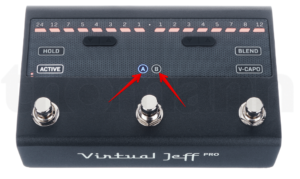
Individual up and down pitch settings for Whammy A and Whammy B with automatic saving of settings and silent switching between the two.
The centre footswitch can then be used to switch between two different settings, with two different pitch ranges independently of each other or combined.
These settings can be permanently stored and are not lost after you power off the unit.
LED Tone Display
Each LED display on the unit is a half step or semitone/fret, with one side “left” being the down pitch and the other “right” being the up.
Both go one octave in semitones each way above/below the original pitch and can be used to set the sonic spectrum of each channel. (See image)

LED Tone Display going up and down by 1/2 steps
Sonic Key Features of Virtual Jeff Pro
Virtuo Capo
The easiest way to change the tuning on your guitar is through the “V-Capo.” This feature applies a fixed change of pitch to the signal, which can drop or up-tune the guitar’s sound far lower or higher than the instrument’s original tuning and has preset options.

Virtual capo for dropping or up-tuning keys on your guitar without using any traditional methods.
Hold
This feature holds the pitch wherever your whammy bar setting is at the time, so if you set the pitch to go down an octave and press hold on the peddle, it stays an octave lower.
This is great for baritone-sounding effects.
Blend
This feature blends the original guitar with the whammy effect, giving you octave pedal tones, striking chorus, pitch-shifting effects, paralleled harmonies, and more.

HOLD freezes the pitch during a bend. BLEND mixes the original guitar signal with the pitched signal (with balance control) for chorus, metal sub-octaves, parallel harmonies and more
The Virtual Capo, Hold and Blend functions offer musicians a range of additional options to expand their creativity.
Added Features
The device also includes a recording feature, allowing players to capture their performances and share them with others.
The device can be connected to a smartphone or computer, where the user can adjust settings and customize the whammy bar’s behaviour.
If brackets are installed on several guitars, the system can be switched from one instrument to another in seconds.
Price
This unit costs $375- 545 USD, which is the same functioning pricing as some similar products like the Digitech whammy pedals.
FQA
VIDEO
PROS & CONS
Final Thoughts
 Few tools are as iconic as the whammy bar in the world of guitar effects.
Few tools are as iconic as the whammy bar in the world of guitar effects.
Having access to this small, often overlooked device can radically alter a guitar’s sound, adding depth and expression to a player’s performance and providing an added layer of texture and versatility.
This tech can give you the best of both worlds: the advantages of a fixed bridge, with tuning stability, attack and sustain, along with the vibrato option without any of the downsides, and a complete unit that comes with everything you need.
Should You Add This To Your Guitar Tool Box?
Yes!
At least if you are not a vibrato bar user and have a guitar this can work on.
Whether used subtly to add texture and nuance to a performance or pushed to its limits to create wild and adventurous sounds, the whammy bar remains a crucial feature of the electric guitar’s sonic palette.
I found that the V Capo feature is especially nice when you are performing with a singer who cannot sing with a key, which needs to be done a certain way on the guitar.
But like most things digital, my only question is the reliability over time and use, so this would be a non-starter, provided the manufacturer’s support is on point.
Did You Like This Post?
Check out our post on the Guitar String Dampener.
Also…
Please leave your comments in the section below, and if you have a favourite player or guitar you would like me to review, leave a note below.
As always, stay the course and keep playing.
Feature image of Squier Classic Vibe 50s Telecaster Electric Guitar, with 2-Year Warranty, White Blonde, Maple Fingerboard-Image courtesy of Amazon.com
Virtual Jeff Digital Whammy bar on feature image courtesy of Reverb.com
4 images of Virtual Jeff Pro floor controller courtesy of thomannnmusic.com
Final thoughts AI-generated images courtesy of Co-pilot

Starting A Journey At 7 Years Of Age, The Love For The Guitar Only Became Stronger Going Into My Teens. This Leading To An Exciting Time Of Teaching, Performing, And Recording. Join Me Now As We Can Bring The Love Of This Instrument To Other Musicians Globally.

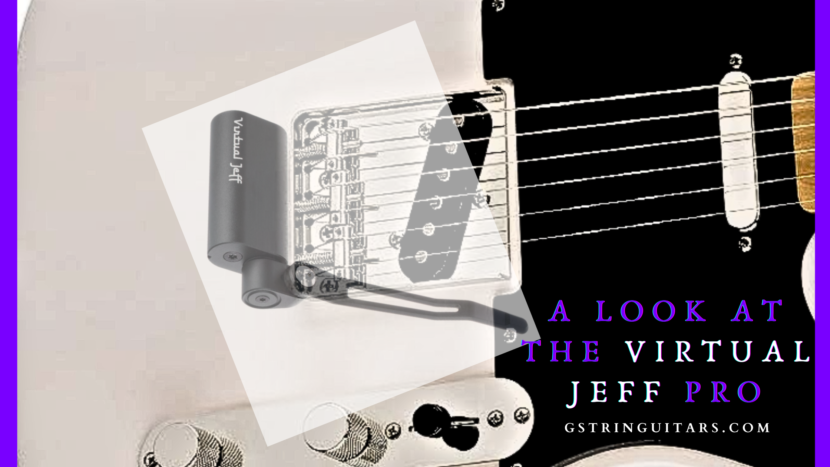
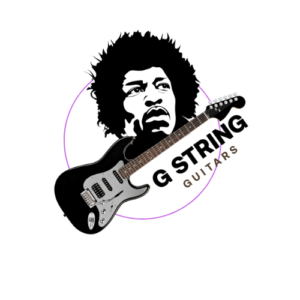





Hi there
Very informative piece.
Your comprehensive approach to understanding how to play while considering the challenges are truly awesome.
I like your mention on how tuning stability takes a hit with vintage-style vibrato systems, often causing the guitar to wander out of tune, especially under vigorous use, owing to the unpredictable tension shifts induced by the tremolo bar.
Then at the same time, heightened tension and bending can precipitate string breakage, particularly with aged strings.
Great work, keep it up
Hi there, Troy
Thank you so much for your kind words and thoughtful feedback! I’m thrilled you found the piece informative and appreciated the comprehensive approach. Knowing that the information resonates with readers like you is always encouraging.
I’m glad you found the discussion on tuning stability and string breakage insightful. These are indeed crucial aspects of playing, especially with vintage-style vibrato systems. Your feedback motivates me to continue creating content that adds value to your guitar knowledge.
Do not hesitate to read more of our posts and leave your thoughts like string dampeners for guitars.
Once again, thank you for taking the time to share your thoughts. I truly appreciate it!
Warm regards.
Dino@gstringutiars